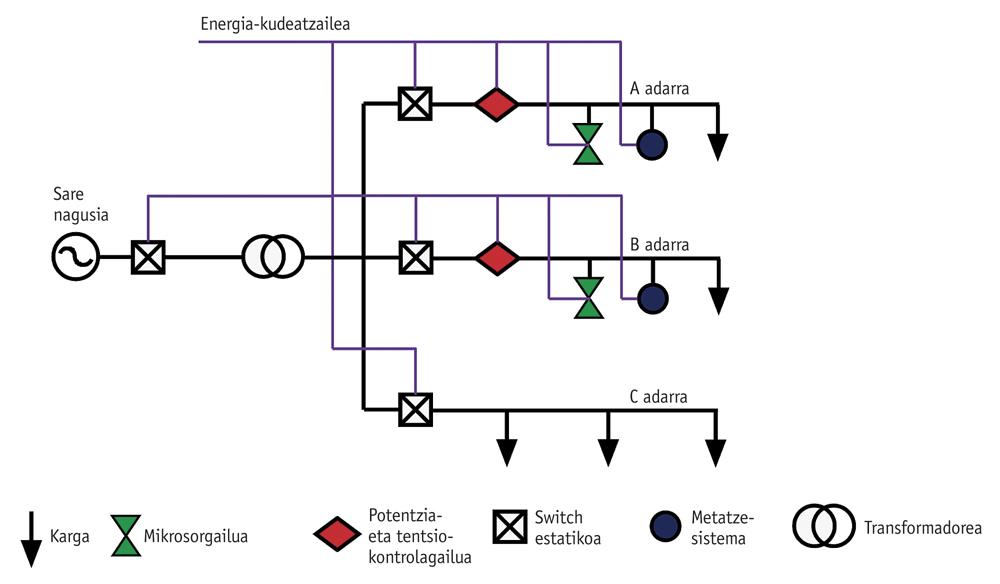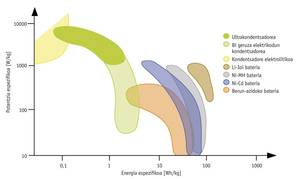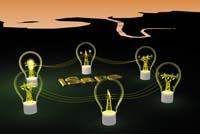Energy storage systems in micronetworks
2014/03/01 Etxeberria Urkia, Aitor - ESTIA-Recherche laborategia Iturria: Elhuyar aldizkaria

Evolution of the power grid
XIX. Since the end of the 20th century (1882) began for the first time in real applications, the power grid has constantly expanded around the world and has radically changed our customs. Today we cannot imagine our day to day without electricity.
But also keep in mind to see what is beyond the plug, how it works and how it evolves in recent years.
In its beginnings, the power grid operated with direct current. The voltage that could be obtained was low, so that this energy could not be transmitted over long distances, since the current intensity to be used generated large energy losses in the transmission cables. In the early years of the power grid, the operation of the network was based on generators installed near the consumption points. Local power generation and consumption. The balance between supply and demand for energy was made by batteries connected directly to the grid.
Years later, in 1886, the emergence of the alternating current allowed the distribution of electricity at greater distances. Using transformers, the voltage began to increase to high values (several kV). In this way, the current needed to transmit the same power was considerably reduced, making transmission viable over long distances. Reducing current intensity resulted in a significant reduction in transmission cable losses compared to losses in DC systems. The transformers of the consumption centers performed the opposite function, that is, they reduced the voltage to low values of both lighting and machines. After the advance in the deployment of the power grid, the centralization of the energy in the large generation facilities begins and its subsequent transfer to the users through the transmission and distribution lines. It was the beginning of the current configuration of the power grid.
Since then, the power grid has been fundamental in both industry and everyday life. However, over the years this centralized power grid has become obsolete. Electricity consumption is increasing and at some points the transmission and distribution lines are saturated. In addition, the energy crisis caused by the limitation of fossil fuels and the concern for climate change has led several countries to introduce changes in energy generation. In this context, the commitment to renewable energy has increased considerably worldwide. On the other hand, the liberalization of the electricity market has led users not only to consume energy but to generate and sell it to the network.
Use of renewable energy sources and microgrids
For all these reasons, more and more renewable generators are connected to the power grid. These generators, compared to centralized installations, are small in size and are usually located near the consumption points. They are therefore called distributed generation generators.
Regarding the use of these distributed generation systems, we can say that the perspective of operation of the electricity grid has begun to change from a centralized operation to a decentralized one.
In general, distributed generation generators have two important advantages: reducing fossil fuel consumption and, being close to consumption points, reducing losses in transmission and distribution lines. The proximity of these small generators to the consumption points allows to use the heat they generate for other applications, such as water heating, which improves the total efficiency of the system.
Most distributed generation generators are based on renewable energy resources such as sun, wind, etc. Since these energy resources are not controllable and their degree of variability is high, their use can jeopardize the proper functioning of the power grid. Therefore, it is essential to integrate the electrical energy they generate in a controlled way in the network. Microgrid is one of the systems being studied to achieve this goal.
As the name suggests, the microgrid is a small electrical network that includes microsensors, accumulation systems, controllers (communication systems, power electronics converters, etc.). and the one formed by loads. One of its most important features is its possibility of operation connected or disconnected to the main mains. That is, the microgrid is able to operate autonomously, so if there is any problem in the main grid, it is able to disconnect from it and continue to supply electric power to its loads.
Figure 1 shows the simplified structure of a microgrid.

The microgrid feeds several branches and connects to the main network at a single point. In addition to being able to disconnect from the power grid, it is able to disconnect the branches it feeds. This could define the priorities of the loads according to their importance. If necessary, the power supply of some loads could be interrupted to ensure the supply of more important loads. For example, in Figure 1 the feeding of the branch C can be interrupted to ensure the feeding of the loads of branches A and B.
Despite its advantages, there are several outstanding questions for the actual implementation of microgrids, so microgrids are currently the central topic of research work.
Need for energy storage systems
One of the problems of the microgrid is that by definition it is a weak network. In this sense, it is very sensitive to power changes that can be derived from both power generators and loads, so these changes can prevent the stability of the microgrid. Therefore, it is essential to use energy storage systems in a microgrid. The main function of storage systems is to maintain an energy and power balance between supply and demand, to ensure the proper functioning of the power grid.
In turn, a system of accumulation contributes to reduce the negative effects of the variability of renewable generators through the controlled integration of energy into the network. An ideal accumulation system that would clear this change potential and at the exit would be constant. Although there is no ideal accumulation system, it can approach this goal.
For a microgrid to accumulate energy a system of accumulation of great capacity, great power, rapid response and long survival is essential. Figure 2 classifies some of the storage technologies currently available based on their specific energy and specific power. These two characteristics determine the energy and power capacities per unit of mass of an accumulation system. They define the energy capacity in Wh of the storage system per kilogram and the power in W.
As can be seen in Figure 2, there is currently no system that offers high energy and power capabilities. Therefore, a possible alternative would be to oversize a system of high energy capacity (or power) to achieve a high power capacity (or energy capacity). However, this would increase the price too much. Therefore, in order to meet the needs of a microgrid it is necessary to use different energy storage technologies by creating a hybrid accumulation system.
This hybrid accumulation system would allow a high capacity, high power, fast response and long survival storage system to store energy. However, although there is a lot of technology, there is no hybrid system capable of giving the most suitable results for all applications. It is necessary to determine the most suitable technology for each application, taking into account the advantages and disadvantages of each of them.
Once the system is selected and its size determined, it is necessary to select the most suitable system of the power converter that allows to control the power flow of the accumulation system and connect the system itself to the micro. The appropriate control algorithm that manages its use will then be designed based on both network conditions and the state of the accumulation system. This algorithm will depend on the optimization of the accumulation system, as well as the maximization of its survival, which depends on its use.
Given the impossibility of understanding microgrids without energy accumulation, the integration and management of accumulation systems in the network is a topic to investigate for the implementation of real applications of microgrids. Accumulation systems play a fundamental role in the microgrids of the future.
References

Gai honi buruzko eduki gehiago
Elhuyarrek garatutako teknologia





